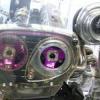R34 3076R Running Temps
Announcements
-
Similar Content
-
Latest Posts
-
By Last Phantom · Posted
Hey crew, Failed my WOF cause of a lower control arm, and I've decided to hit both arms, and also the compression rods at the same time(seems they're gonna be the most likely upcoming failure points from some discussions with the lads over on the G35 reddit). I've looking at these form Z1: https://www.z1motorsports.com/front-suspension/hayaku-automotive/hayaku-g35-front-compression-rod-p-40716.html https://www.z1motorsports.com/front-suspension/hayaku-automotive/hayaku-g35-front-lower-control-arm-p-40674.html I asked Z1 if they'd work as it's the same platform, just RHD vs LHD. I basically got told "Lol dunno". Specifically they aren't aware of any difference but can't guarantee fitment as they haven't done it on a 350GT. So guess I'm asking is if there is any issues with using 2005 G35 coupe suspension parts on a 2005 350GT coupe? Orginally I thought it could be something in the way of the arms that each control arm is designed to be positioned around, but that'd be an engineering nightmare for Nissan needing two different shaped control arms 😅 -
^ This. The mode door actuator is a common failure, as is the actuator and/or the actual valve for the coolant flow control valve. I also don't know how available the mode door actuator is these days. I've been meaning to look into it and get one from wherever is possible, to keep in the shed for the rainy day when mine eventually fails. Anyway, the advice to you is to search the usual NOS part supply places, or even just go to Nissan and see what they list.
-
Have you got a pic of the actuator? My guess is that unit has failed internally and was flopping around, so the previous engineer who owned it forced it to be fully open to cold air (blocking the heater core path). As far as you can tell, is anything else wrong in the system? Likely you just need a new actuator (not sure how available they are) and then "installation is the reverse of disassembly"
-
I'm happy with the Lsailt unit that I put in, it puts full Android on the top screen so you can run whatever Nav and other Apps you want, while still existing inside the factory functionality like automatic reverse cams, audio input switching, retains factory bluetooth etc. Not cheap and the install was moderate (not simple, not hard) Yours is a V36 not V37 though right?
-
Yeap, all the NC's that I originally looked at that had a hard top were PRHT, which makes the roof line look horrible, hence why I said nope to them My only caveat for another MX5 was it needed to have a hard top, and initially I didn't think you could get a detachable hard top for the NC, like my NB had Again, a big thanks to Matty for helping me source the detachable hard top for my little girl, they are as rare as hens teeth in Australia, and the few people who have them, keep them Also to Greg, for initially pointing me in the NC direction NC PRHT 🤢🤮 Not mine (I really should take more photos of my car), but a NC with the detachable hard top 😁 To me, the difference in how the detachable hard top roof line looks, and how it actually follows the bodies lines, like they do on NA's and NB's, is chalk and cheese compared to the bulbous looking PRHT
-






Recommended Posts
Create an account or sign in to comment
You need to be a member in order to leave a comment
Create an account
Sign up for a new account in our community. It's easy!
Register a new accountSign in
Already have an account? Sign in here.
Sign In Now